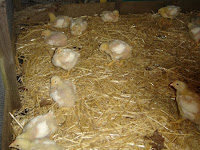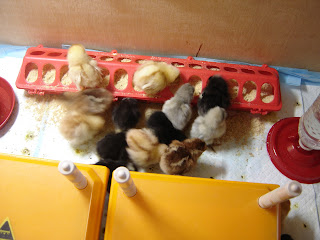Chicks have been delivered by the USPS all across the country for over a hundred years. Chicks can survive without food or water for about three days, and the Postal Service typically delivers chicks in the 48 states in about 48 hours. However, with the current changes in the USPS rules, and delivery processes being slowed down, the life and health of a chick is put at stake by these new standards. So it goes. I am going to need to change my expectations of a safe delivery from one of the few no-kill hatcheries within the US. There are several no-kill hatcheries on the East Coast, but I had found one in the Mid-west that had been able to get chicks to me within 48 hours. This year? Um.... Big Sigh.
The weather didn't help. I normally order chicks for delivery the last two weeks of February. That was a "no go" for this year. Weather had the Mid-west battening down their hatches and the Postal Service was not accepting live animal deliveries of any kind during those weeks. The first week of March, our chicks were shipped out one day before another big cold front swept that area. The chicks were shipped not from the Mid-west, but from a different hatchery, from the South, with no heat pack and no gel packs in the event of a delay or cold temps. Harsh Reality. While normally, the chicks would have arrived early Wednesday morning, instead, they arrived late in the morning, like almost mid day, ON Thursday.
Five chicks had already died en route. We lost another fifteen within 24 hours of arrival despite our best efforts to save them. Four more died over the next week. Some of the survivors were slow to recover, while others bounced back within the first 24 hours. But each day, it was emotional to find another lost chick, day by day.
Typically, the first weekend after the chicks arrive, the older grand kids come over to help us do health checks. We did the best we could to protect the kids from having to see or handle the ones that we suspected were going to die soon, but yah, they are instinctively drawn to the ones who are the most vulnerable.
All in all, the majority of the chicks made it. We have 40 healthy chicks and half of those are already reserved for local backyard farms.
To make up for the lost expense and the potential revenue of the chicks that died, we have placed a new order for early May with a hatchery closer to us. Granted, it's not a no-kill hatchery, but we need to find some way to supplement the lost funds that we count on to help pay our property taxes. Ordered 30 layer chicks for that May group, and then ordered another 15 chicks for the second weekend of July. Ordered some rare breeds because we can sell them for a little more than the common breeds even though it costs us the same amount to raise them. So, hoping for the best.
Now, on to the gardening. We purchased two more fruit trees for the mini orchard. This month, we planted two dwarf cherry trees.
The raspberries that we planted in large tubs last spring survived the winter. That's good because I was really dreading the thought of having to plant new ones for the fourth year in a row. Granted, we took extra precautions to cover them with crop blankets this year, but of course, that blew off in the first of the strong east winds that came in right after the freeze. UGH. Yah, need to find a better option for that.
Last fall, we dug up the compost out of the bottom of the kitchen waste compost pile, moving the uncomposted pile to a new location to continue it's breakdown. We also keep a chicken and duck compost pile that we fill with the straw and shavings we remove from the coops. So, we did a "Lasagna" compost over the rainy fall, winter and early spring months. We took a couple of old plastic garbage cans that we had attempted to "store" chicken feed in, in the garage that the rats chews holes in the bottoms to access the feed.... UGH. So putting those cans to better use since the rats had already created the holes in the bottoms, we piled layers of garden soil, dead leaves, kitchen compost soil, and poultry compost soil. We did this three times. Around mid winter, we stirred/turned it, and yah, it looks sooooooo good! This spring, I dumped some of it into the bottom of some planting pots, and filled the top with potting soil. Have some Tomatoes and some Bell Peppers starting in the pots in the green house. Fingers Crossed. Also have some lettuce and some herbs in the green house too. Those always grow, no matter the soil.
Moved the duck pen closer to the house around the two raised garden beds. They are having a wonderful time out there. Rats followed them up to that area though. Not happy about that. The rats dug big holes/trails from the duck coop up under the green house, so I have rat poison in the green house. These rats are too big even for cats to kill. So, I have no qualms with poisoning them. We also have a big rat trap, but that's it's own process to set it up, stage it and entice rats to it. For now, let's hope the poison thins them out. (Update - rats are too smart for the poison. Need to come up with a better plan.)
Another positive is the fact that Diego the Duck did not get bumblefoot this year! Woot! Fingers crossed she doesn't get it, in all this mucky mud. But normally, by now, she would have it. Watching her closely. All our ducks are laying eggs now, and we have plenty duck eggs for all our duck egg customers.
That's about it for now. Spring has Sprung and it is wet wet wet and slog slog slog around here. Fingers crossed for no late frosts like we had last year.


















































